PERSPECTIVE
Have you noticed all the articles lately about how recycling centers nationwide are closing? Here’s just one, from The Atlantic, no less: “The End of Recycling.” This is news, for sure, spurred on by China’s 2018 refusal to take any more of our too-contaminated bundles. (See related hand-out in my blog’s Resources section.)
We’re up against it, folks. Many municipalities are indeed at loose ends for effective (read: profitable) disposal of collected recyclables, and they resist charging consumers more for removal, even as they get higher bills from the collection agencies for the same service.
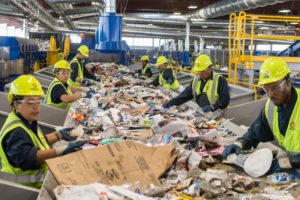
“It’s the economics,” we’re told, over and over again – – and this is true. There are steadily increasing costs for cleaning up, packaging and shipping contaminated recyclables, but reduced payoffs (from whomever will take the processed materials) because of such minimal market for downcycled* items. And stressed landfills are raising prices for taking what doesn’t even try to get recycled (including much that could be but isn’t).
*Most recycling is actually downcycling; it reduces the quality of a material over time. —William McDonough and Michael Braungart in their 2002 manifesto, Cradle to Cradle: Remaking the Way We Make Things
Plus, manufacturers have been allowed to “externalize” disposal costs (meaning simply that they are not responsible for the demise of their products, so other parts of the culture have to deal with and pay for that inevitability). This in turn provides many brand new goods at still very (unrealistically) cheap prices – – especially plastics.
Thus the lack of market incentive for producing recycled goods, which will only become profitable when new products actually reflect their true lifetime cost (such as when environmental clean-up costs are somehow factored in and shared). The EPR movement (Extended Producer Responsibility) is a hopeful pathway forward.  Tires, electronics and floor coverings are a few industries that are exploring new models for product disposal accountability.
Tires, electronics and floor coverings are a few industries that are exploring new models for product disposal accountability.
But unfortunately I still think things will get worse before they get better. China gets blamed, but shouldn’t, really. They’ve got enough of their own waste to deal with and we’ve been deluding ourselves for years because they would too easily take much of ours off our hands (sending the barges, emptied of recycling, back across the Pacific filled with manufactured goods – – that only add to our mountains of waste).
We’ve had an ostrich-in-the-sand approach to the entire system. —Jeremy O’Brien, director of applied research at the Solid Waste Association of North America, a trade association.
The ultimate problem is that we continue to just consume like crazy, as if all that waste was going to go somewhere out of sight and out of mind. Well, the contaminated chickens are coming home to roost. Our habits are drowning us in refuse, if we are courageous enough to look. And our slow-to-adjust capitalist economy is not helping. 
This is our big challenge: How do you take a culture like [ours] and get people excited about less? —Debbie Raphael, director of the San Francisco Department of the Environment.
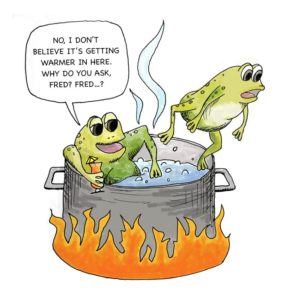 Maybe it’s akin to the analogy often applied to how climate change has supposedly snuck up on us: a live frog in a pot of gradually heating water doesn’t notice the temperature change until he’s cooked.
Maybe it’s akin to the analogy often applied to how climate change has supposedly snuck up on us: a live frog in a pot of gradually heating water doesn’t notice the temperature change until he’s cooked.
We haven’t noticed how we’re inundated with unmarketable refuse – – although I suspect the people who have to live near landfills are certainly feeling the heat more than many of us.
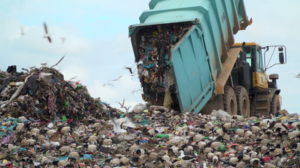
Meanwhile, municipalities are squeezed, and they admit to taking what looks like an easy way out with their accumulating unwanted mounds of recyclables: either incinerate or dump them.
But landfills are the third largest source of methane in America. (Garbage doesn’t compost out there; it just stews and spews.) 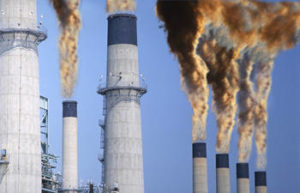
And burning plastics adds both floating toxins and carbon to our air, such that all our current incinerators release more harmful chemicals than our coal plants. So much for dealing with climate disruption.
But wait! The National Renewable Energy Laboratory (NREL) says, “Don’t Recycle Single Use Plastics—Upcycle!” Upcycling encourages us to creatively repurpose an item without degrading or breaking down its original material to make it into something else (which would be downcycling and can actually require more energy). 
Materials made of the very common single use plastic known as PET* (polyethelene terephthalate) are acceptable in most recycling programs. However, creative engineers have been busy figuring out how to better repurpose this ubiquitous element.
*PET is a plastic resin, labeled #1, frequently holding products such as beverages, peanut butter, bakery goods, produce, frozen foods, salad dressings, cosmetics, and household cleaners.)
“Standard PET recycling today is essentially ‘downcycling,’” said Gregg Beckham, a senior research fellow at NREL. “The process we came up with is a way to ‘upcycle’ PET into long-lifetime, high-value composite materials like those that would be used in car parts, wind turbine blades, surfboards, or snowboards.”
This is encouraging news, in the face of much that is less so. Necessity can indeed be the mother of invention, but do we as a consumer culture really feel the need to change? And can we scale up the upcycle revolution fast enough?
PRACTICAL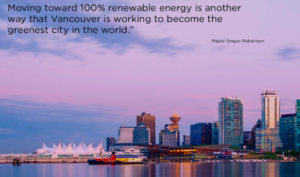
Over this past year I’ve been spending some time in Vancouver, B.C., where they are quite ambitious about recycling – – and reducing consumption! (See their “Greenest City 2020 Action Plan.” It’s a solid and inspiring model for anyone anywhere.)
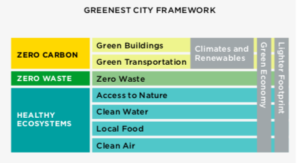
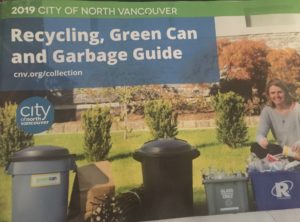 The City of North Vancouver, for instance, issues an easy-to-follow brochure to all residents that opens with 5 Rs to consider before recycling: Reduce, Reuse, Repurpose, Repair, Refuse.
The City of North Vancouver, for instance, issues an easy-to-follow brochure to all residents that opens with 5 Rs to consider before recycling: Reduce, Reuse, Repurpose, Repair, Refuse.
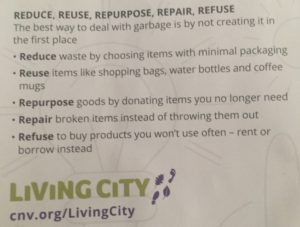
“The best way to deal with garbage is by not creating it in the first place.”
Those crazy Canadians.
Many people around the globe have effectively been “upcycling” for decades, using old packaging and clothing in new ways, being conservative with food, etc., although often more out of personal need than for environmental preservation.
As more and more folks from the generation of Americans who lived through the Depression Era of the 1930s depart from our midst, they take with them many relevant conservation experiences and skills that were devalued after WW II, when so-called modern conveniences (not to mention the savior Plastic) became a seductive rage. We can and do still learn a lot from their inventive and prudent strategies, born of necessity perhaps, but nonetheless worthy.
Better, of course, to not purchase single-use items (or wrappings) in the first place, but if you do, take a few moments to think before just disposing of them. Be creative. Search the web for ideas.  One of my favorite sources for ideas is TrashBackwards – – loaded with specific ways to repurpose what might have been thrown “out.” (Find it on Pinterest, Twitter and Facebook.)
One of my favorite sources for ideas is TrashBackwards – – loaded with specific ways to repurpose what might have been thrown “out.” (Find it on Pinterest, Twitter and Facebook.)
 Wikipedia’s definitional entry for Upcycling profiles these realms in which goods that would otherwise be disposed of are given new life: art, music, industry, libraries, design processes, technology, and clothes.
Wikipedia’s definitional entry for Upcycling profiles these realms in which goods that would otherwise be disposed of are given new life: art, music, industry, libraries, design processes, technology, and clothes.
And it also offers a helpful qualifier, suggesting an assessment of how much total energy is required to upcycle (or downcycle) any item into its next incarnation. As we are learning, “footprints” that tell a larger story of full impact can help guide us to best focus our own energies.
Helping lead the upcycle charge is TerraCycle, a global innovator in repurposing hard-to-recycle waste. 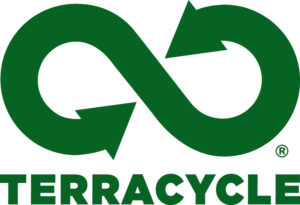 Operational since 2001, “TerraCycle offers a range of free programs funded by conscientious companies, as well as recycling solutions available for purchase for almost every form of waste. To date, over 202 million people in 21 countries have helped to collect and recycle enough waste to raise over 44 million dollars for charities around the world.”
Operational since 2001, “TerraCycle offers a range of free programs funded by conscientious companies, as well as recycling solutions available for purchase for almost every form of waste. To date, over 202 million people in 21 countries have helped to collect and recycle enough waste to raise over 44 million dollars for charities around the world.”
TerraCycle will, for instance, convert drink pouches into backpacks and cookie wrappers into pencil cases or kites. They pay schools and other groups a small amount to send in old packaging to be upcycled. They have created a huge global market for recycled beach plastic. Etc. Etc. Check them out!
Recycling well matters, but consumption reduction may be our greatest challenge, since it requires changing daily habits – – not something Americans are particularly eager to do, evidently. But I feel it’s actually the “low hanging fruit” in our efforts toward mitigating the effects of climate disruption. We may feel we can’t impact the shrinking of ice caps and subsequent sea level rise, say, but we sure can adjust what we bring into our households each week and the ways we dispose of our daily waste. 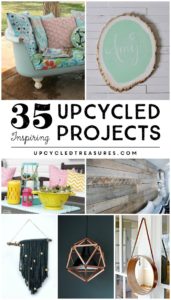
And if more and more of us will do that, it can make a huge difference.
FINER POINT
If you see an item frequently (in the everyday stream of products flowing around you) that could possibly be upcycled – – even if you don’t know quite how yet – – consider a fair way to store it or them. Then wonder out loud among friends and colleagues how it might be creatively repurposed. You might well be guided by the universe toward a helpful activity or donation that keeps some things out of the landfill.
For instance, for a while some years ago, when I was regularly buying frozen concentrated orange juice, I methodically saved the two perfectly round metal lids from each canister, thinking they must be good for something. 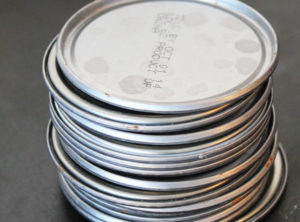 I made a few holiday tree ornaments out of them, but still had stacks and stacks before I ever figured out what else I might do with them, and as I was preparing for a move, I asked around and found an elementary school that put the bunch of ‘em to good use in various class projects. Huzzah!
I made a few holiday tree ornaments out of them, but still had stacks and stacks before I ever figured out what else I might do with them, and as I was preparing for a move, I asked around and found an elementary school that put the bunch of ‘em to good use in various class projects. Huzzah!
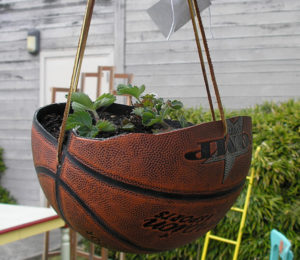 I urge you to regularly say the word “upcycle” or “upcycling” out loud and in conversation with others, to bring it more into your own and your community’s consciousness. Then imagine how you might repurpose something before just throwing it “away.”
I urge you to regularly say the word “upcycle” or “upcycling” out loud and in conversation with others, to bring it more into your own and your community’s consciousness. Then imagine how you might repurpose something before just throwing it “away.”
Upcycling to the Rescue!
Many thanks for your good efforts!
Above image sources (not otherwise obvious):
ostrich-in-the-sand:
https://www.mediastorehouse.com.au/ardea-wildlife-pets/ostrich-head-sand-1451011.html
So. Nevada LineWork:
EPR-Canada:
KidsAfloat:
boiling-frogs-drawing:
Landfill dump:
https://www.pond5.com/stock-footage/68800329/large-truck-dumps-waste-landfill.html
Incinerators:
Car front couch:
https://www.loveproperty.com/gallerylist/71768/68-upcycling-ideas-to-transform-your-old-stuff
OJ can-lids:
https://30minutecrafts.com/2013/04/recycled-juice-can-lid-garland.html
Basketball planter:
http://www.thisismelo.com/feature/the-7-ways-to-upcycle-your-basketball/



